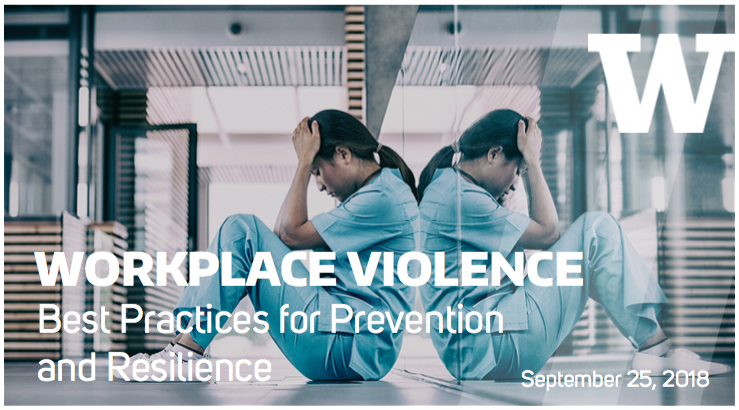How to Create a Robust California Workplace Violence Prevention Plan for Your Organization
How to Create a Robust California Workplace Violence Prevention Plan for Your Organization
Blog Article
The Duty of Employee Training and Recognition in Enhancing Workplace Physical Violence Avoidance Initiatives Across Numerous Industries
The combination of staff member training and awareness right into workplace physical violence avoidance efforts is increasingly acknowledged as a basic aspect of organizational safety and security across diverse markets. By executing targeted training programs, services can effectively equip their labor force to recognize and deal with prospective hazards before they intensify. Nonetheless, the effectiveness of these initiatives commonly pivots on several vital variables that vary by industry, increasing crucial inquiries concerning the adaptability of training approaches and their real-world impact. Understanding these nuances might disclose approaches that can significantly enhance safety protocols and employee confidence in risky settings.
Significance of Training Programs
In today's vibrant workplace, the significance of training programs can not be overemphasized, especially in the context of workplace physical violence avoidance. These programs act as a fundamental aspect in cultivating a secure and safe work environment culture. By equipping staff members with the understanding and skills needed to identify, minimize, and respond to possible dangers, companies can foster an atmosphere that focuses on security and wellness.
Reliable training programs do greater than just instruct; they equip employees to acknowledge caution indications of physical violence, understand the methods for reporting events, and create strategies to de-escalate prospective conflicts. Moreover, they infuse a sense of cumulative responsibility among personnel, encouraging positive engagement in maintaining a risk-free office.
Investment in training not only improves staff member awareness but likewise demonstrates an organization's dedication to guarding its labor force. This proactive method can cause lowered incidents of workplace violence, lower absenteeism, and enhanced worker spirits. Inevitably, thorough training programs are integral to developing a resistant business culture that values security and promotes a healthy job setting, therefore decreasing the threat of physical violence and its associated repercussions.
Trick Elements of Effective Recognition
An extensive awareness program encompasses several essential parts that are essential for effectively stopping office physical violence. First, clear interaction of procedures and plans associated with office violence is crucial. Workers must be notified regarding the organization's position on violence and the certain procedures in location for reporting events.
2nd, training sessions must incorporate sensible circumstances that staff members may experience. This practical approach assists employees acknowledge cautioning indicators of possible physical violence and furnishes them with the needed skills to de-escalate tense circumstances. Third, fostering a supportive office society is essential; staff members need to feel empowered to speak out without fear of retaliation.
Furthermore, continuous education is very important to maintain recognition fresh and appropriate. Routine correspondence course and updates on arising risks can enhance workers' watchfulness and preparedness. Last but not least, including feedback mechanisms allows employees to share their insights and experiences, which can cause continuous renovation of understanding campaigns. By incorporating these parts, companies can develop a robust structure for preventing office violence, eventually adding to a much safer and extra productive atmosphere for all staff members.
Industry-Specific Training Strategies
Reliable work environment violence avoidance training have to be customized to the distinct challenges and threats dealt with by particular industries. Medical care atmospheres require training that attends to the high possibility of experiences with aggressive patients or site visitors. Programs ought to concentrate on de-escalation methods, recognizing indication of possible violence, and making certain personnel understand the significance of reporting incidents.
In comparison, retail setups may encounter different hazards, such as burglary or consumer disputes. Training in these settings ought to stress situational awareness, action protocols throughout emergency situations, and the significance of safeguarding cash and belongings.
Production and construction markets offer their own threats, typically connected with interpersonal disputes or unsafe working problems. Training in these fields ought to consist of approaches for dispute resolution, advertising a society of safety, and motivating open interaction amongst employees.
Additionally, company workplaces may need training fixated preventing harassment and bullying, promoting a considerate workplace culture, and executing clear reporting systems. Each sector must not only acknowledge its details vulnerabilities but likewise adjust training products to resonate with the workforce successfully, making certain that employees feel complete and equipped to handle prospective fierce circumstances.
Determining Training Efficiency
Examining the influence of office physical violence avoidance training is critical for making certain that staff members are properly prepared to deal with potential threats. To accurately measure training performance, companies must execute both qualitative and quantitative find out here now assessment approaches. Pre- and post-training studies can assess modifications in employee expertise, perspectives, and habits concerning office physical violence. These surveys should concentrate on certain training goals to ensure placement with the company's goals.
Additionally, functional assessments, such as role-playing circumstances or simulations, can offer understandings into just how well employees use found out skills in real-life scenarios. Checking event records before and after training can likewise work as a sign of performance, as a reduction in occurrences might reflect enhanced staff member preparedness.
Moreover, feedback from participants must be systematically gathered to recognize locations for improvement in training material and distribution. Conducting follow-up examinations at normal intervals assists endure recognition and reinforces link training principles gradually - california workplace violence prevention. By using a comprehensive method to gauging training performance, organizations can guarantee that their work environment physical violence avoidance initiatives foster a much safer atmosphere and boost total staff member well-being
Building a Culture of Security

Educating plays a crucial role in this social change. Normal, thorough training sessions educate employees about recognizing warning indications of work environment violence and the suitable actions. Moreover, motivating open interaction enables workers to voice worries without concern of vengeance, promoting collective responsibility for safety.
In addition, incorporating safety right into day-to-day procedures guarantees that it becomes a shared worth instead of a mere compliance concern. This consists of regular safety drills, updates on plans, and comments mechanisms that entail workers in security conversations and renovations.
Eventually, a robust society of security not only minimizes the dangers of workplace physical violence however also improves employee spirits and efficiency. By fostering a setting where security is a fundamental concern, organizations can develop resilient offices that support both specific wellness and cumulative success.
Final Thought
In final thought, employee training and understanding are essential elements in the avoidance of office violence across different sectors. Reliable training programs, tailored to specific market demands, improve staff members' ability to react and identify to possible hazards.

Routine, detailed training sessions inform workers regarding acknowledging warning signs of workplace physical violence and the proper actions.In final thought, employee training and awareness are essential parts in the avoidance of work environment violence throughout different industries.
Report this page